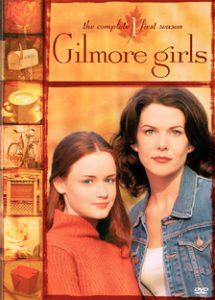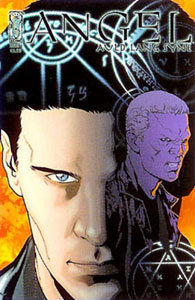While IDW’s “Angel” title still resists an ongoing narrative, the five-issue “Auld Lang Syne” (November 2006-March 2007) is a nice step up from the standard tortured-Angel story “The Curse” and the catching-up-with-the-gang “Old Friends.” Scott Tipton, who had shown a good grasp of Wesley in “Spotlight” and “Masks,” turns his focus to two living (well, undead) characters – Angel and Spike – in this third series set after Season 5.
It starts off notably similar to Jeff Mariotte’s “Old Friends,” in that Angel and Spike are wandering about Los Angeles encountering doppelgangers of long-dead nemeses. Although it’s a bit irritating that neither of them say “Hey, didn’t we just do this last week?,” “Auld Lang Syne” feels more substantial than “Old Friends.” David Messina’s art still favors shades of black, but he makes nice use of sparse color.
Angel’s and Spike’s noir narration works well as Angel (in Issue 1) meets “Drusilla,” “Darla” and “the Master,” and Spike (in Issue 2) encounters copies of the two Slayers he had offed, as chronicled in “Fool For Love” (B5.7), plus his mum from “Lies My Parents Told Me” (B7.17). Although it’s still pretty shallow, Tipton seems slightly more into the “ghosts of the past” concept than Mariotte was.
Issue 3 is an excuse for a flat-out Angel vs. Spike fight, the comic-book answer to “Destiny” (A5.8). Both vampires-with-souls go all-out, assuming that the other is a doppelganger. While never a plot-heavy series, “Auld Lang Syne” becomes more story-oriented in the final two issues as Angel and Spike work together to find out and dispatch whoever is doing this to them.
Wesley is dead and still very much missed, but his home library is still there; maybe Angel is living in Wesley’s apartment? Angel pulls out an old tome and learns that Lilitu is the villain of the week. She feeds off torment, so a pair of vampires with souls is an exquisite feast for her. Angel and Spike go through a dimensional portal where the first vista they see is a field of wooden spikes to the horizon. Lilitu’s lair is a standard underground cavern befitting an arrogant demon.
Tipton doesn’t suffuse “Auld Lang Syne” with much that’s new or insightful, but he does do a good job of illustrating the love-hate (well, more like “tolerate-loathe”) relationship between Angel and Spike and the fact that they make a good team when they have to.
One intriguing revelation comes on the final page, when the vampires note that Buffy was not among the doppelgangers from their past because thinking about her makes them happy. That doesn’t line up with all previous writings on the subject, but I can see how casting their thoughts to Buffy would be bittersweet more so than torturous, so it works.
“Auld Lang Syne” is a respectable character sketch for Angel and Spike with solid artwork, but it’s becoming apparent now that IDW’s “Angel” title leans heavily toward character pieces and is unwilling to tell a meaty, plot-oriented story — nor any kind of yarn with forward momentum. That should finally change with the next arc under the “Angel” banner, “After the Fall.”

Click here for an index of all of John’s “Buffy” and “Angel” reviews.

